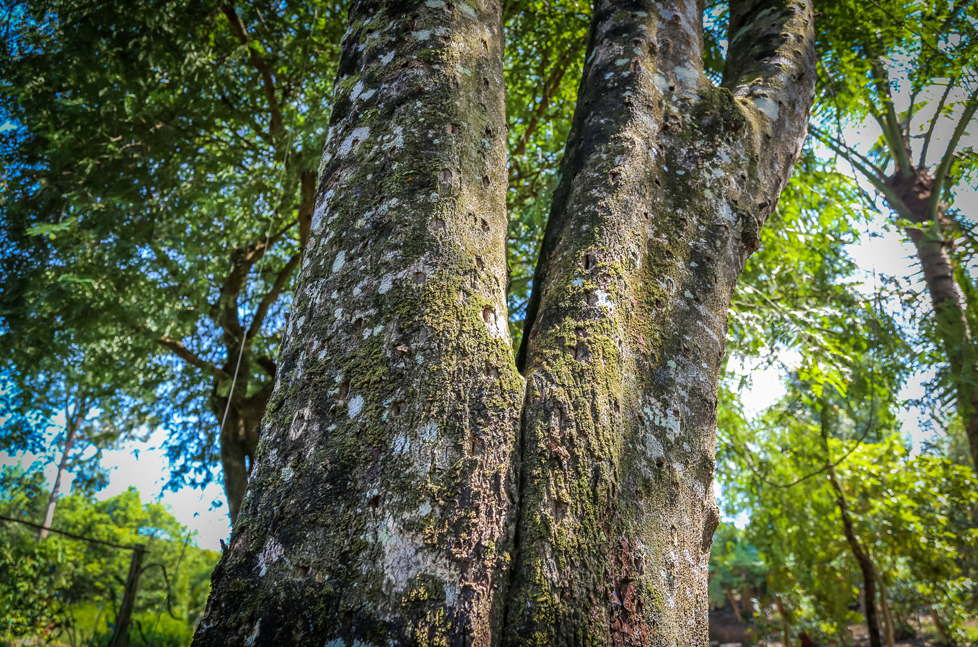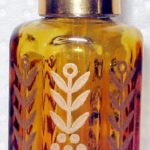Agarwood Oil (Oud Oil, Aloeswood Oil, Eagleswood Ud, Kiara…) is an extremely rare and precious natural Oil obtained from several species of Agarwood trees. This, which originates in North Eastern India, Bhutan and parts of South East Asia, has a very long history of use as a medicine, incense and as an aromatic Oil.
Agarwood is a very complex, deep woody fragrance, reminiscent of amber. It has a balsamic, ambergris, woody, deep fragrance. To experience the many nuances of this unique substance is like a journey on the road to spiritual perfection.
The Oud are extremely rare and very difficult to obtain. By purchasing agarwood Oil from cultivated trees, we are not doing damage to the last remaining wild agarwood trees, nor to the forests in which the precious agarwood trees grow.

Agarwood trees must be infected by a fungi, prior to producing an oleoresin which saturates the wood.
This oleoresin saturated wood is where the mystical fragrance of Oud originates.
There are many grades of agarwood: the essential Oil can cost $1.000 per ounce and the highest quality wood is extremely expensive ($13.000 per 16 ounces).
Please realize that this Oil is from cultivated trees, and is not considered a high quality agarwood Oil. It is a very nice Oil (pure and unadulterated) at a very affordable price.
The Oud CO2 extract that we carry is a very viscous, dark brown Oil. It is non-sticky and can be applied directly to the skin (in minute amounts).
Oud Oil from the Agarwood Tree
Few perfume Oils have the mystique of Oud (this is also referred to as Agarwood, Aloeswood and Eaglewood). It has been loved and treasured for thousands of years, by mystics (as an aid to spiritual meditation) and romantics alike (as an aphrodisiac).
Indeed, the hunger for Oud is so great that in most parts of the world Agarwood trees are nearing extinction. Most of the Agarwood on the market is now obtained through poaching (while trees dwindle, the demand keeps growing) because it exceeds $27.000 per pound.


Very interesting Agarwood article
Several decades ago, enterprising farmers in Thailand began a major replanting of Agarwood trees throughout the region. Agarwood nurseries have produced tens of thousands of healthy seedlings for Agarwood plantations, and everyone is being encouraged to once again plant these beautiful trees in their yards.
Practicing organic, sustainable harvesting methods, these Agarwood plantations and extraction centers are providing good livings for honest families, and insure that these amazing trees will survive for generations to come. The Agarwood Oil they produce is extremely high quality. All the work is done by hand, with sincere respect and dedication for the trees and the land.
Another recent development to conserve the precious Aloeswood is the use of CO2 extraction instead of distillation. CO2 extraction does not use any solvent chemicals, making it environmentally-friendly. Instead, it uses the same carbon dioxide that is in soda pop. CO2 extraction is so powerful that it requires less wood than steam distillation to obtain the same amount of Oud. And because it doesn’t use any heat, Aloeswood CO2 extract has a much more vibrant fragrance that is truer to life.
Aloeswood Oil from CO2 extraction smells earthy, woody and sweetly balsamic. It is rich and complex, not burned or musty-smelling like some heat-distilled Ouds. A good perfume house will provide affordable samples of their Oud.
So as you shop for Oud, remember to find out how it was obtained, and how it was extracted. Support the people who truly love the Agarwood tree, not those who merely exploit it. Buy from a supplier with a good reputation who makes samples available.
- AGARWOODS
- OUD AL KHULUD 14865/D
- AGARWOOD CAMBODIA BAILONII 44578-3/D
- AGARWOOD BURMA TOP OLD 68327/D
- AGARWOOD INDIA ROYAL 86298/D
- AGARWOOD IMPERIAL VN 68398/D
- AGARWOOD NAGALAND TOP 68287/D
- AGARWOOD INDIA CHURAN 1ST JAAL OLD 68374/D
- AGARWOOD BIO INDONESIA 86200/D
- AGARWOOD INDIAN HAAT 44874-2/D
- AGARWOOD CAMBODIA SIHANOOK 86390/D
- AGARWOOD INDONESIA 64286/D
- AGARWOOD PRACHIN 40300/D
- AGARWOOD ETERNAL 40300-12/D
- AGARWOOD INDIAN 10726-11/D
- AGARWOOD INDIAN 10726-15/D
- AGARWOOD SOUTH THAILAND 40300-7/D
- AGARWOOD MANIPUR ROYAL 68456/D
- AGARWOOD MYSTERIOUS WILD 69598/D
- AGARWOOD WHITE LAOS 63230-2/D
- AGARWOOD INDONESIA AQ 64285/D
- AGARWOOD CAMBODIA KHO KONG 68298/D
- AGARWOOD CAMBODIA BIO 40843-5/D
- AGARWOOD CAMBODIA BIO 40843-8/D
- AGARWOOD CAMBODIA 68357/D
- AGARWOOD CAMBODIA 68357-2/D
- AGARWOOD MALAYSIA 62001/D
- AGARWOOD SUPREME 62000/D
- AGARWOOD SUMATRA 64487/D
- AGARWOOD INDIAN 10726-9/D
- AGARWOOD SABAH 44484-5/D
- AGARWOOD PAPUA 44584-2/D
- AGARWOOD 44584/D
- AGARWOOD PRACHIN 68459/D
- AGARWOOD CRASSNA AAA 68396/D
Indian Agarwood Oils
(ex Aquillaria Agallocha and Aquillaria Khasiana)
- Agarwood Manipur 88122/D. Second fraction of an old tree.
- Agarwood India KHKH 88123/D. First fraction of the most mature tree. A product widely used by Royal dignitaries in the Middle East. May be the best and most refined quality in the world.
- Agarwood Bhutan 88188/D. Excellent quality also sold to the top people knowing the world of agarwood oils. A certain second fraction of KHKH. Origin Bhutanese trees.
- Agarwood Burma 88818/D. Mixture of Aquillaria agallocha, Aquillaria Khasiana and Aquilaria Malacencis present in Burma and not in India/Bhutan. Origin Burma.
Indonesian, Malaysian, Cambodian Agarwood Oils
- Agarwood Indonesia 88604/D. Mixture of various Aquillarias present in Indonesia. Strong masculine leathery.
- Agarwood Indonesia 88422/D. Very elegant, woody and long lasting. May be the better accepted in Western markets.
- Agarwood Malaysia 88654/D. Harsher and more leathery that Indonesian agarwood oil but very masculine.
- Agarwood Cambodia 88765/D. Ex Aquillaria Bailonii and Aquilaria Crasna ex Pierre Lecompte. Top note sweet-honey-like but extremely woody dry down. Mixes well with Western floral accords. The first ever agarwood oil distilled by us. Traditional with big market.
- Agarwood Cambodia 88650/D. One of the nicest and purest agarwood oils from Cambodia. It is extremely appreciated in many Royal fragrances.
- Agarwood Auram 88456/D. Excellent and impressing leathery, animal and woody note.
- Oudh éternelle 88186/D. One of our most successful blends of many types of agarwood oils.
Bio Agarwood Oils
(Not to be confused on the word bio as it is understoon in Europe)
- Agarwood Bio M 88444/D. Process studied by Auram during the last 20 years infecting parts of it-bio- but being masterly reconstituted in order to achieve agarwood oils that are more affordable imparting the same note as naturals do.
- Agarwood Bio I 88445/D. Same as the last one but with different infection and with a dry down having more body than 88444/D.
- Agarwood Bio IJ 88446/D. For many people the most perfect reconstitution of agarwood oils in the world, also having an infection type Irian Jaya, Papua New Guinea.Those bios are sensational, especialy when mixed with Frangipani Abs., Melatti Abs. DM, Foin Absolute DM, Beeswax Absolute, α-Vetivone, especial refined grades of myrrh and opoponax oils, our extraordinary Fixodor Ambrine 10245/D that imparts “glory” to all our agarwood oils, both traditional and Bios. Also extraordinary with our Divine Flowers 10809-2/D our Makkah 10261/D, our Irian Jaya 40660/D and our unique Treasure 44688/D, being may be the best successes in the GCC Middle East markets.
These Bios are produced by tons, they smell 95% close to the traditional agarwood oils we used these bios internally for years and they were only promoted to some of the top multinational companies. We have recently decided to open them to the market captive products in our company just used in our internal fragrances. They are extremely long lasting, to be smelled in the smelling strip but also in the skin and having a lastingness of minimum 24 hours in the skin (36,5º- 37º Celsius).
Agarwood oils are being focused in Europe, the US and Japan by the best perfumers and are being used more and more since they are unique, in France there are many companies working exclusively for the Middle East and making extremely expensive sprays “made in France”. The knowledge of these products will be for sure treasured by them.

We have thousands of successful accords where Agarwood oils are used but some of the best we made are made with the best quality of Rose oils (ex Damascena from Bulgaria and Turkey) and ex Bourboniana from India. These accords agarwood/roses, they blend excellently well with Orris Absolute, Osmanthus Absolute, Saffron derivatives (Resinoids) and the top fraction of Saffron DM, Real Amber Gris absolute, Musk Abs, (also made for us in Grasse) or synthetic substitutes like our Amber Gris 10064-2/D or 10338/D or our Musks Abs. 10760/D (the finest reconstitution of the natural product using on it the coveted laevo Muscone) and Musk Animal 10676/D; Our coveted Shamama 10174/D (Co distillation of roots, flowers, herbs, woods, seeds on Indian sandalwood oil (quality 8863/D) or Sandalwood chemicals (10174 and 10175/D), Yougo Mosses abs., Copahu Oil Coeur, Cypriol and Jatamansi Coeurs, Patchoulol cryst., our Patchoulenolia 40206/D (Nor Patchulenol 1% solution), Geranium Bourbon oil, Frangipani flower abs. (especially with Cambodian), Chinese Magnolia flower Oil DM,Night Queen Absolute, gardenia oils, especially our fantastic specialty 10808/D, Terpeneless absynthe oil, Myrrh, Sandalwood Oil Mysore, Frankincences ex Boswelia Sacra (only distilled by us and giving effects very different from the oils distilled ex Boswelia Carterii), Castoreum Abs., Mango leaf Abs., Horsegram Abs., Violet leaf abs. from France, Rose Absolute DM, Kewra oil 100% pure and natural, also excellent qualities of Pyrogened Frankincense oils and top chemicals like Laevo Muscone, Helvetolide, Firsantol, Paradisone, Mysoral, Myrrhone (Dihydro irone) dextro Nor limbanol, Pomarose, Limbanol, Serenolide, Paradisamide, Crystanol, Trisamber, Cosmone, Hydroxyambran, 9-Epiambrox (a liquid and extraordinarily powerful chemical), Ambermax, AmberXtreme, Ambrocenide, Javanol, would mix great with them. also α-Vetivone and Dihydro-α-Vetivone, etc. etc.
HISTORY
In the Old Testament, “#Aloes” (#Agarwood / #Oudh) is mentioned several times. And four out of the five times it mentioned, Aloes is used conjunctively time with myrrh. Nicodemus brought a mixture of myrrh and aloes to Jesus and in the garden of the beloved, it smells likes “with all trees of frankincense; myrrh and aloes, with all the chief spices…” #Agarwood was not only present but was also held in as high regards as myrrh was. In the Quran and in the Bible, the Queen of Sheba, from a kingdom in the southern Middle East gave King Solomon gifts of #Agarwood among other things.
Yemen, in the southern Middle East was already trading with India by the time of King Solomon. Since a lot of the ancient perfumes from the Middle East, such as myrrh and frankincense found their way into Chinese and subcontinental cultures. It would be reasonable to assume that Arab traders were bringing back agarwood from India and the Far East where they originate.
Ibn Battuta, a traveller in the 14th century gives wonderful accounts of the #Agarwood he saw in Hindustan, Java, and Ceylon:
On the sea-shores, aloes like seed-aloes, sold by measure, just as meal and millet is…The whole of its shore abounds with cinnamon wood, bakam, and the kalanji aloe.”
To highlight the abundance of #Aloeswood Ibn Battuta also mentions how Ayari Shakarti, a local ruler, kept a saucer made of ruby filled with #Aloeswood oil (Lee, 2009).
Sindbad, a protagonist of one of the tales of the Arabian Night, buys aloeswood from Ceylon before he returns home from his fifth voyage (Pearson, 2003).
#Agarwood also finds itself in the works of Kalidasa, a renowned classical Sanskrit writer:
Beautiful ladies, preparing themselves for the feast of pleasures, cleanse themselves with the yellow powder of sandal, clear and pure, freshen their breast with pleasant aromas, and suspended their dark hair in the smoke of burning #Agarwood.
#Agarwood was used socially as much as it was used in religious settings in the forms of incense. The Vedas prescribed the methods and ingredients needed to create incense. And because incense gave pleasant aromas they began to be used in Ayurveda to heal.
As Buddhism appeared in India it absorbed some Hindu customs—incense use permeated Buddhist traditions as well. #Agarwood was used in incense. Though the transition is not very well described or recorded, ithe use of agarwood in incense influenced the development of using agarwood to make prayer beads. Buddhist monks still use prayer beads made with agarwood. The Buddhist monks using agarwood in incense and in their prayer beads may have been responsible for introducing agarwood use to China when they wandered there to spread Buddhism.
By the early 3rd century China was already facing an increasing demand for agarwood that did not grow there then. Besides being used in incense, #Agarwood was also ingested as a traditional medicine in China. There is no information on how that trend emerged. The increasing demands for #Agarwood in China led to an increased sophistication in agarwood grading that is still more sophisticated than any other grading system in the market. While traders from the United Arab Emirates use a six-point grading system, Chinese traders have a more elaborate system.
The increasing demand for #Agarwood lured Chinese traders to Vietnam, which was a large producer of agarwood then (Hansen, 2000). In her book, “Nguyen Cochinchina: Southern Vietnam in the Seventeenth and Eighteenth Centuries.” Tana Li states that the Nguyen Lords established a “monopoly over the sale of Calambac.”
In their report, “The Use and Trade of #Agarwood in Japan” compiled for Convention on International Trade in Endangered Species(CITES) James Compton and Akikio Ishihara quote the Nihon-shoki (Chronicles of Japan):
«#Aloeswood (#Oudh) drifted ashore on the island of Awaji (near Kobe). It was six feet in circumference. The people of the island, being unacquainted with aloeswood, used it with other firewood to burn for cooking; the smoky vapour spread its perfume far and wide. In wonderment, they presented it to the Empress”.
They mention that agarwood was introduced to Japan along with Buddhism in the 6th century and how it continued all the way into the 19th century until the Meiji Restoration. They also mention how it had become a symbol of wealth and power in feudal japan. Nobles were known to burn huge pieces of agarwood to flagrantly demonstrate their wealth and power..!!!
LAUNCHING AGARWOOD JEWEL CAMBODIA AND PRACHIN AND MYSTERIES OF AGARWOOD OILS, WOODS AND SMOKES
Everybody knows what agarwood is and I am not going to repeat if in this short monograph paper. I started talking about agarwood when I read a paper at the University of Manchester for Science and Technology in May 2004. I have lectured many times in my life and in 25 countries. However, this was a conference for scientists, high people of research in our “aromatic world” and it is indeed the lecture I have enjoyed most in my life. I met and shared time with excellent colleagues like Dr. Hiroyuki Matsuda from Takasago, Dr. Anubhav Narula from IFF, Regula Naef from Firmenich and so many others as Dr. Michael Zvieli.
This year in April, I visited several colleagues and we started talking about agarwood and its mysteries, just to smell the great collection of pure samples that I brought with me and we smelled with great care and pleasure the top notes of pure Indian old from Aquillaria Agallocha, quiet cheesy and fecal; Thailand’s Agarwood “Kanankoh” ex Aquillaria Crassna es Pierre Lecompe, so fruity (tobacco-osmanthus, α-oxoionyl isobutyrate-like) and a bit cheesy too, also distilled in the Cambodia’s region of Koh Khong although the original Cambodian botanical species is “Aquillaria Baillonii Pierre ex Lecompte” a totally unknown oil made by us and marketed under the reference Cambodian Top 44578/D; This tree is also found in Laos and it is mixed with the main Laotian tree (aquillaria Crassna ex Pierre Lecompte) and our company has made a reputed oil distilling both of them called in the market “The Royal White Laos oil” being our product Agarwood White Laos TP 44580/D; Wild Eastern Malaysia from Sabah’s Agarwood ex Aquilaria Beccariana, dry, woody and one of the best qualities I have smelled in my life, Sumatra’s Pokambaru ex Aquilaria Malaccencis, again dry, woody, diffusive, extremely elegant being a “breaking heart smell”; Indonesia’s Kalimantan ex Aquillaria Microcarpa Baill, having the same notes with shades as compared with the two previous ones although sweeter than Wild Beccariana and less rounded off as compared with “Pokambaru” ex Aquilaria Malaccensis; Thailand’s Prachinbury ex Aquillaria Subintegra Ding Hon, (wild and cultivated with Artificial inoculation); Western Malaysia’s ex Aquillaria Malaccensis cultivated which by the way smells a bit weaker on the top note but develops a very long lasting and extremely noble woody note almost unparalleled!!!; Vietnam ex Aquillaria Banaensis P.H. Hô and ex Aquillaria Rugosa Kiet & Kessler, (by the way the real natives of central Vietnam); Laos ex Aquillaria Crassna; China ex Aquilaria Sinensis Lour from Hainan island and ex Aquillaria Yunnanensis S.C. Huang from North Vietnam and south Chinese Yunnan jungles. We smelled the rare variety ex Aquillaria malaccensis from Selangor, south West Malaysia which has almost no color and a strong woody note believing to be imparted my many chemicals although Jinkohol, Jinkohol II are important is this species.
We smelled wild fresh oil, wild aged oils, cultivated fresh oils and aged oils, we smelled and smelled and sensed and sensed these oils that although very strong when pure and natural 100%, the spiritual attraction was more important than the tiredness felt when smelling too much.
However, this time shared with my friend and colleague Michael has been experienced by me almost every day for the last 30 years and I can say I know about the chemical composition of the oils and what is also very important, its smell that it is not composed by the top note smell at all. I share the knowledge achieved after hard work by the team of chemists from Firmenich led by Regula Naef which is the most serious ever made in the world having got some results quite similar to mine and everybody knows how I admire my old Swiss company, so this is an act of reverence again, not only for what relates to Agarwood oils and wood but for an extraordinary scientifically research which is without discussion the best in the world.
There is only a discrepancy since Firmenich scientists mention that Aquillaria Agallocha and Aquillaria Malaccencis are the same and I have travelled across the Indian States of Assam, Mysoram, Tripura, Manipur and deep inside Burma and on the jungles of Chittagong, Bangla Desh and the oils coming from the distillation of the Aquillaria Agallocha species is about the same with a cheesy and animal, fecal strong top note while the oils coming from the Aquillaria Malaccensis species are not animal, not fecal and having an extraordinary dry wood; this dreaming and extremely noble, dignified, fine and splendid wood smell of all the agarwod oils.
So what is the reason why I am talking about a mystery, if not many mysteries, observed on the agarwood oils of the world? Well, it is easy to understand if you have spent thousands of hours as I did smelling agarwood. These agarwood oils smell extremely different on their top notes, namely coiraceous, animal, fecal, fruity, extremely leathery (being the most leathery those coming from Papua New Guinea and Indonesia’s Irian Jaya regions, those we call Jayapura and Mereke), cheesy, phenolic but when evaporating in the skin after 7 to 8 hours, all of them change to create the most noble, extraordinary, unexpected, surprising, amazing and astonishing woody note that has existed in the world. The dry down became all the same. Why? I smelled many of the chemicals found in Agarwood oils, from those simple and not important that everybody knows like benzyl acetone, furfuraldehyde, Frambinone Methyl ether, p-cresol, furfuryl alcohol, creosol, styrene, p-vinyl anisole, fatty acids, etc., chemicals which are not important at all. Some olfactory important that I personally dislike as Butyric, 3-Methylvalerianic, Caproic, Caprilic, Cyclo hexanoic acids etc, . and those I believe are really “keys” in the fabulous smell sought since a millennium and being the favorite smell of Asian aristocrats in Vietnam, China, Japan, Thailand or the Indian Maharajas…. And I firmly believe that the top note differences in the oils are created by not important ingredients while the “treasure” is in the ingredients almost nobody know but of course known by the Firmenich scientists and by me. So what happen? Why so many different oils have such a different top note, very often for me unpleasant and suddenly its smell changes to impart the extraordinary woody note that is so resinous, fragrant, radiant and delicate?
Personally, I prefer the oils which are not fecal, not cheesy and that is why I trend to avoid for my personal consumption the cheesy ones (Boyas from India, Bangla Desh, Laos) or the oils ex Aquillaria Agallocha or Aquillaria Khasiana and accept and want the oils from Malaysia, Indonesia, Papua New Guinea (although it is very strong) and those from Thailand (Prachinbury ex Aquillaria Subintegra, Trat ex Aquillaria Crassna and those from Cambodia ex Aquillaria baillonii and Crassna too (the one called in the market Koh Khong) For my personal liking these are the best agarwood oils.
Why all these oils become so woody and treasure the best smell in the world on its dry down…? It is very risky to reply but there are some “key” ingredients than make the miracle.
I believe the miracle is made by,
(+)-(4αS,5R)- Dihydrokaranone.
One of the best chemicals I have smelled in my life, being powerfully woody, resinous, timbered extraordinarily diffusive and not easy to forget once known and smelled. This is on of the best woody chemicals in the world!
(-)-Guaia-1(10),11-dien-15, 2 olide.
Its smell is very strong, as the previous one extremely long lasting, with orris sub notes, clean, radiant, diffusive, bright, woody ambery, smelling a bit of Ambrocenide, Ambrostar, dextro Nor Limbanol, Ambermax, Cachalox, Z-11 and Limbanol whose greatness is to make us feel harmony in our souls and as a perfumer I believe its smell it is like these kind of spiritual emotions so difficult to describe.
Jinkohol (2-epiprezizaan-7β-ol)
Again a storm of the noblest woods we can imagine, again a moving smell, again something that touches our subjective world, again something sensitive, receptive, insightful that you cannot describe but providing an extremely rich creativity to every good and skilled perfumer.
(8,12)-Epoxyeremophila-9,11(13)-diene.
Softer than Jinkohol of Dihydrokaranone but imparting a special sweetness which combines extremely well with those described before and especially mixed with (-)-Guaia-1(10),11-dien-15-al. The accords of these 5 chemicals bring to you the smell of the mysterious woodiness of agarwood oils and here I say oils since all of the, bring the same results regardless of the different top note.
(+)-(4αR,5S)-Karanone.
Again it is extremely woody but with very important amber gris notes as important as the woody ones. Karanone would mix extraordinarily well with pure amber chemicals such as Ambrox classique (the original one containing ambrols) and by far the best, α-Ambrinol, Limbanol, Ambrostar, Laevo Cetalox, Super Ambrox, Amber Xtreme, Ambrocenide, Cachalox, Ambrinoloxide, Dehydro ambrox, Dihydro-γ-ionone, (much better than its homologues α and β and that so many people ignore in spite of its extraordinary and unparalleled softness), Timbersilk, Dextro Nor Limbanol, Trisamber, etc., etc.
Jinkohol II.
Again very woody and smelling of agarwood smoke something quite strange because when we distill the oils we do not get the more than 35 chromones being present in the woods and the presence of chromones is what makes the smell of the smoke richer, exalted, splendid, high, lofty and I would term as glorious… the chromones do not come on the distilled products and only on the extracted ones by Acetone, Benzene, supercritic CO2, etc. being the most important ingredients for the smoke of agarwood, amongst them 2-(2-Phenylethyl) chromones, the 2-(2-Phenylethyl)-tetrahydro chromones more mysterious that the other ones mentioned before and others. And when talking about the “wood” one of our top business, the amount of chromones is what will make you successful with your customers most of them Royals since it does not burn the same a wood with 65% of chromones or a wood with only 10% of them. Again, nothing to do with the oils but the burning of these high noble ingredients I am describing with the chromones, produce spiritual peace and I have felt this and seen it many times in my life. Luckily, I have in my houses more than 50 kilos of the best agarwood woods, those called “kanankoh”, from India, from Laos, from Vietnam, from Cambodia, from Indonesia, from Malaysia, from Bhutan, from Irian Jaya and Papua New Guinea and I wish to burn them very often to feel I am in the “Platonic pink Cloud” as described many times in my books.
Eremophila-9,11-dien-8-one.
A very unstable chemical and very difficult to detect through GC/MS since most of it, on the injection conditions of the GC injector it decomposes and forms more Dihydrokaranone. However, by itself it is a lovely smell and we should not forget that in agarwood, the ketones are the noblest ingredients as happen in vetyver too where the best smell is given by α-Vetivone, Dihydro-β-vetivone, Didehydro-β-vetivone, Didehydro-α-vetivone, Dihydro-α-vetivone, Khusimone, β-Vetivone, etc…. so both oils are what I define as noble “ketone” oils.
(-)-Guaia-1(10),11-dien-15-al
This mixes very well with the described “epoxieremohilladiene” and has a beautiful note of β-Damascenone which is very rare on these chemical structures but also an orrisy-diffussive and radiant smell with reminiscences of Irones and Dihydroirone. Its woodiness it is extremely soft, almost of having soul and spirit…
I could continue hours and hours but this is not my task in this short paper, however I have disclosed a mystery and a secret to all of you and I know the reason why in spite of so many differences on the top note, the agarwood oils produced from 19 aquillarias and some other related species especially in Indonesia (Other than Aquillarias) come to its common origin and incredibly attractive smell, the unbelievably royal and aristocratic woody not, by far the best found in this world.
Another problem of agarwood oils to be incorporated massively in the Western Perfumery it is its price and not enough availability. Even now, when cultivating the trees and inoculating them artificially, you can find producers boasting they make 50 kilos per month and what is this? Can a product like this to be used massively in international perfumery? The answer is not, categorically not. That is why my company which worked 30 years in Agarwood research is about to launch the “Jewel” series of our scientifically reconstitutions that smell 95% close to the natural product, remain in the skin more than 24 hours and weeks in the smelling strips and cloths. This “jewel” collection contains only Malaysian and Indonesian oudh oils, especially Sabah, Kalimantan and Moluccas islands although we made too the Cambodia Baillonii, Kho Kong, Trat and Prachinbury but those are not to be launched yet because in the West we generally like much more the Malaysian and Indonesian oils and the perfumery international market is located in the West, so these members of the “Jewel” collection are our references 40828-4/D, 40828-7/D, 40878-8/D and 40878-9/D, they are reasonably priced and they are produced already by tons and this availability is a “must”. Just in January 2014 we will launch our Agarwood “jewel” Cambodia 40830/D and our Agarwood “Jewel” Prachin 40834/D (both captive for internal use of our company so far) Naturally, many companies launched “Oudh” fragrances in the market but none of these fragrances contain agarwood oils at all and I would quote them as Cypriol more or less masked and simply “labeled” as Agarwood.
We live or wish to believe in a time of miracles, the situation of our world is becoming worse and worse as written in my books since years and years… What I predicted was going to happen in 1979 is simply happening and it is written, however we need an idealistic approach to life and to love what we do and for me CG/MS and NMR research is a passion but I do not forget the critical state of the world surrounding me and I often remember a note left by the Russian Grand Princess Olga Nikolaeva Romanova, a daughter of last Russian Tsar Nicholas the II, when in 1918 wrote a beautiful phrase we should all make ours… She said not long before dying,
“Father asks us to remember
that the evil which is now in the world
will become yet more powerful.
And it is not evil which conquers evil,
but only love”
early June 1918
Arcadi Boix Camps, December 21st., 2013





